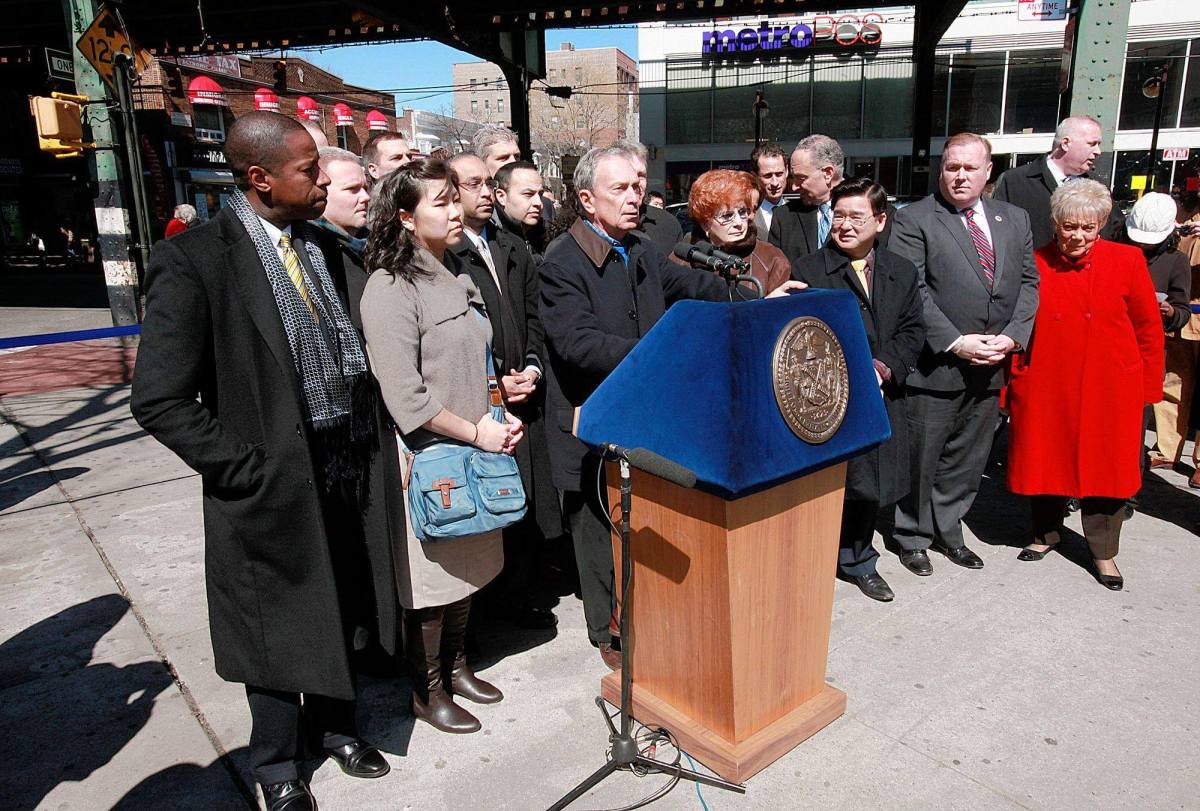By Howard Koplowitz
The U.S. Census has determined Queens gained only 1,334 residents from 2000 to 2010, but Mayor Michael Bloomberg and Queens elected officials say something does not add up.
Bloomberg announced Sunday in Jackson Heights the city will file a formal challenge under the Census’ Count Question Resolution process — a form of appeal — arguing the numbers are flawed and Queens’ population increase was higher than the Census recorded.
The Census reported a measly 0.1 percent rise in the borough’s population — from 2,229,379 residents in 2000 to 2,230,722 in 2010 — leaving Bloomberg and the borough’s elected officials scratching their heads.
The white population in the borough dropped by about 15 percent — from 732,895 residents in 2000 compared to 616,727 in 2010, according to the census.
Meanwhile, the Asian population soared 30 percent, according to the figures. There were 391,500 Asians living in the borough in 2000 and 511,787 in 2010.
The black population declined by 4 percent, from 446,189 residents in 2000 to 426,683 in 2010.
Hispanics and Latinos of any race increased by 10 percent in the borough, from 556,605 residents in 2000 to 613,750 in 2010.
Bloomberg said the Census was way off in finding that Jackson Heights had a decrease of about 5,200 residents, or a 5 percent drop, between 2000 and 2010.
The once-in-a-decade count, which determines how hundreds of millions of federal dollars are spent on schools, hospitals and other city services and is used to redraw electoral districts, also found a drop of about 1,300 occupied units in Jackson Heights and an increase of 1,200 vacant units, Bloomberg said.
Similar figures were cited in Astoria, which Bloomberg said are wrong.
“Everything we know about these neighborhoods tells a very different story,” he said. “These are vibrant, vital communities. People who have tried to find apartments in these neighborhoods can confirm that there just isn’t an abundance of vacancies.”
City Councilman Leroy Comrie (D-St. Albans) said the language barrier was a problem in immigrant-heavy communities such as Jackson Heights and Richmond Hill, where census response rates were poor.
“I saw in Jackson Heights people who had no Spanish-speaking ability,” he said.
State Sen. Malcolm Smith (D-St. Albans) noted that Arverne by the Sea, a development project in his district, provided housing for about 900 residents.
According to the Census, southeast Queens’ population dropped by 47,130 residents between 2000 and 2010, from 688,620 people to 621,690, but Smith said he is not buying those figures.
“For the U.S. Census numbers to suggest that the borough has only seen a 0.1 percent population increase over the last decade is nothing short of ridiculous and an insult to the thousands of people who have relocated to Queens and made it their home,” Smith said.
He said he supports U.S. Sen. Charles Schumer’s (D-N.Y.) request for an investigation account and will stand by Bloomberg if he plans to file a lawsuit to contest the numbers.
U.S. Sen. Kirsten Gillibrand (D-N.Y.) also called for corrections to the count.
“It is critical that the Census Bureau gets this count right so we don’t lose critical federal funding over the next decade,” she said. “I will continue to work with federal and city officials to correct this undercount and ensure our communities get their fair share of federal resources.”
City Councilman Eric Ulrich (R-Ozone Park) said he was “disappointed” by the figures.
“My office went to great lengths to help people understand the importance of the 2010 Census in relation to making sure that our communities receive the proper funding for essential services,” he said. “Given the construction boom that has taken place over the past decade, the determination that Queens gained a little more than 1,300 residents would be laughable if it didn’t come with such serious consequences.”
Ulrich referenced the small increase on his Twitter account.
“The best part is that they’re all living on my block,” he joked.
Councilman Jimmy Van Bramer (D-Sunnyside) also believes Queens was undercounted.
“Common sense is lacking in this Census formula and before these numbers go to print there should be a serious review of this methodology that greatly affects our city’s funding,” he said. “In a time where every penny counts, New York City should not be shortchanged.”
U.S. Rep Gary Ackerman (D-Bayside) said not every borough resident was counted.
“As a former math teacher, I can tell you that the census count doesn’t add up. The figures released by the Census Bureau are absolutely bizarre. I know of no neighborhood where there are fewer people than there were in the last census,” he said. “But I know of scores of neighborhoods where the population has increased in multiples, particularly within the ethnic and minority communities in Queens.
“We understand how difficult it is to conduct these types of population counts,” Ackerman said. “But the fact of the matter is that everybody was not counted at a time when everybody should count.”
Reach reporter Howard Koplowitz by e-mail at hkoplowitz@cnglocal.com or by phone at 718-260-4573.

































